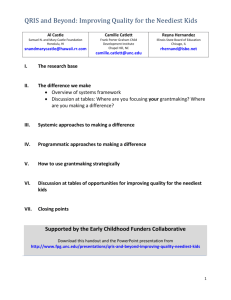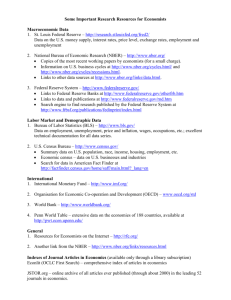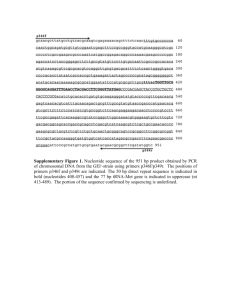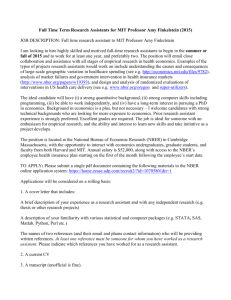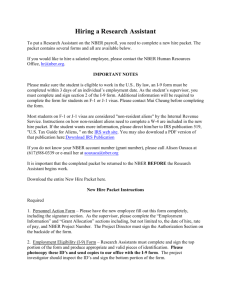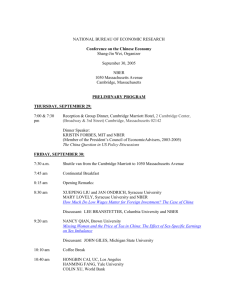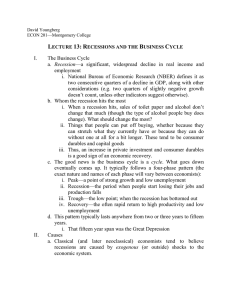Document 11225408
advertisement
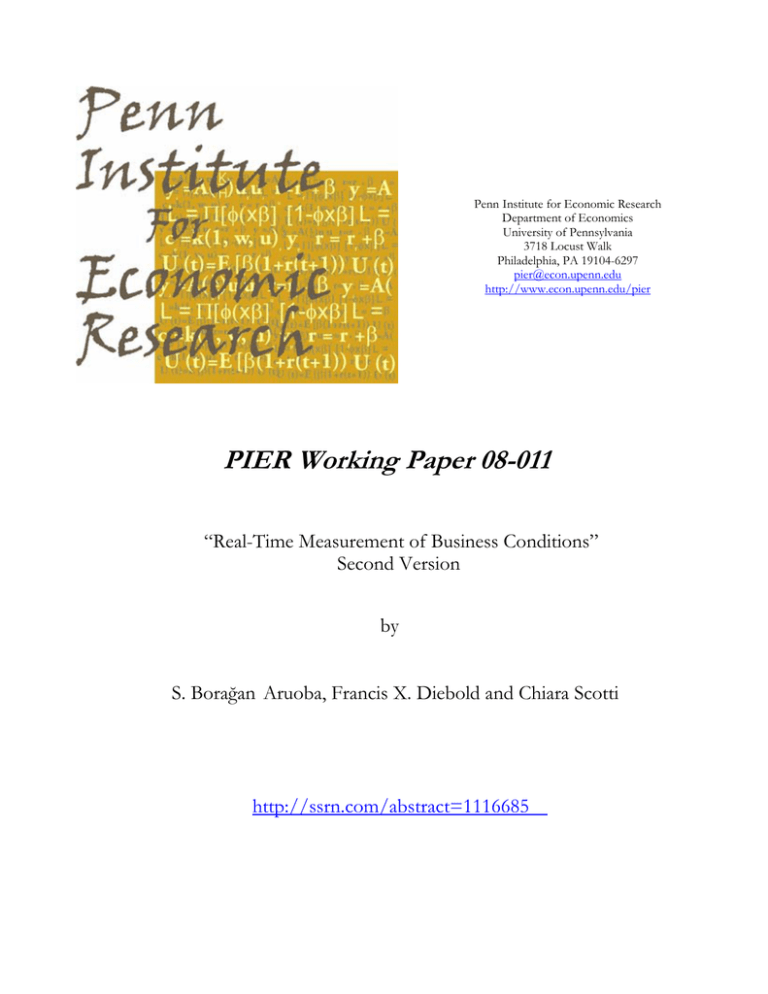
Penn Institute for Economic Research
Department of Economics
University of Pennsylvania
3718 Locust Walk
Philadelphia, PA 19104-6297
pier@econ.upenn.edu
http://www.econ.upenn.edu/pier
PIER Working Paper 08-011
“Real-Time Measurement of Business Conditions”
Second Version
by
S. Borağan Aruoba, Francis X. Diebold and Chiara Scotti
http://ssrn.com/abstract=1116685
Real-Time Measurement of Business Conditions∗
S. Borağan Aruoba†
Francis X. Diebold
Chiara Scotti
University of Maryland
University of Pennsylvania and NBER
Federal Reserve Board
First Draft: March 2007
This Draft: April 4, 2008
Abstract
We construct a framework for measuring economic activity at high frequency, potentially in real time. We use a variety of stock and flow data observed at mixed
frequencies (including very high frequencies), and we use a dynamic factor model that
permits exact filtering. We illustrate the framework in a prototype empirical example
and a simulation study calibrated to the example.
Key Words : Business cycle, Expansion, Recession, State space model, Macroeconomic forecasting, Dynamic factor model, Contraction, Turning point
JEL Codes: E32, E37, C01, C22
∗
For helpful guidance we thank the Editor, Associate Editor, and referees, as well as seminar and conference participants at the Board of Governors of the Federal Reserve System, the Federal Reserve Bank of
Philadelphia, the European Central Bank, SCE Cyprus, and American University. We are especially grateful to David Armstrong, Carlos Capistran, Martin Evans, Jon Faust, John Galbraith, Eric Ghysels, Sharon
Kozicki, Steve Kreider, Simon van Norden, Alexi Onatski, Simon Potter, Scott Richard, Frank Schorfheide,
Roberto Sella and Jonathan Wright. We thank the National Science Foundation for research support. The
views in this paper are solely those of the authors and do not necessarily reflect those of the Federal Reserve
System.
†
Corresponding author. Department of Economics, University of Maryland, College Park, MD 20742.
aruoba@econ.umd.edu
1
1
Introduction
Aggregate business conditions are of central importance in the business, finance, and policy
communities, worldwide, and huge resources are devoted to assessment of the continuouslyevolving state of the real economy. Literally thousands of newspapers, newsletters, television
shows, and blogs, not to mention armies of employees in manufacturing and service industries,
including the financial services industries, central banks, government and non-government
organizations, grapple constantly with the measurement and forecasting of evolving business
conditions. Of central importance is the constant grappling. Real economic agents, making
real decisions, in real time, want accurate and timely estimates of the state of real activity.
Business cycle chronologies such as the NBER’s, which announce expansions and contractions
very long after the fact, are not useful for guiding such decisions.1
Against this background, we propose and illustrate a framework for high-frequency business conditions assessment in a systematic, replicable, and statistically optimal manner. Our
framework has four key ingredients.
Ingredient 1. We work with a dynamic factor model, treating business conditions as an
unobserved variable, related to observed indicators. Latency of business conditions is consistent with economic theory (e.g. Lucas, 1977), which emphasizes that the business cycle
is not about any single variable, whether GDP, industrial production, sales, employment,
or anything else. Rather, the business cycle is about the dynamics and interactions (“comovements”) of many variables.
Treating business conditions as latent is also a venerable tradition in empirical business
cycle analysis, ranging from the earliest work to the most recent, and from the statistically
informal to the statistically formal. On the informal side, latency of business conditions is
central to many approaches, from the classic early work of Burns and Mitchell (1946) to
the recent workings of the NBER business cycle dating committee, as described for example
by Hall et al. (2003). On the formal side, latency of business conditions is central to the
popular dynamic factor framework, whether from the “small data” perspective of Geweke
(1977), Sargent and Sims (1977), Stock and Watson (1989, 1991) and Diebold and Rudebusch
(1996), or the more recent “large data” perspective of Stock and Watson (2002) and Forni,
Hallin, Lippi and Reichlin (2000).2
Ingredient 2. We explicitly incorporate business conditions indicators measured at differ1
We do not wish to imply, however, that the NBER chronology is not useful at all. Indeed it is exceptionally useful for what it is: A retrospective historical chronology of business cycles.
2
For discussion of small-data vs. large-data dynamic factor modeling, see Diebold (2003).
2
ent frequencies. Important business conditions indicators do in fact arrive at a variety of
frequencies, including quarterly (e.g., GDP), monthly (e.g., industrial production), weekly
(e.g., employment), and continuously (e.g., asset prices), and we want to be able to incorporate all of them, to provide continuously-updated measurements.
Ingredient 3. We explicitly incorporate indicators measured at high frequencies. Given
that our goal is to track the high-frequency evolution of real activity, it is important to
incorporate (or at least not exclude from the outset) the high-frequency information flow
associated with high-frequency indicators.
Ingredient 4. We extract and forecast latent business conditions using linear yet statistically optimal procedures, which involve no approximations. The appeal of exact as opposed
to approximate procedures is obvious, but achieving exact optimality is not trivial, due to
complications arising from temporal aggregation of stocks vs. flows in systems with mixedfrequency data.
Related to our concerns and framework is a small but nevertheless important literature,
including Stock and Watson (1989, 1991), Mariano and Murasawa (2003), Evans (2005) and
Proietti and Moauro (2006), as well as Shen (1996), Abeysinghe (2000), Altissimo et al.
(2002), Liu and Hall (2001), McGuckin, Ozyildirim and Zarnowitz (2003), Ghysels, Santa
Clara and Valkanov (2004), and Giannone, Reichlin and Small (2008).
Our contribution is different in certain respects, and similar in others, and both the differences and similarities are intentional. Let us begin by highlighting some of the differences.
First, some authors like Stock and Watson (1989, 1991) work in a dynamic factor framework
with exact linear filtering, but they don’t consider data at mixed frequencies or at high
frequencies.
Second, other authors like Evans (2005) do not use a dynamic factor framework and do not
use high-frequency data, instead focusing on estimating high-frequency GDP. Evans (2005),
for example, equates business conditions with GDP growth and uses state space methods to
estimate daily GDP growth using data on preliminary, advanced and final releases of GDP
and other macroeconomic variables.
Third, authors like Mariano and Murasawa (2003) work in a dynamic factor framework
and consider data at mixed frequencies, but not high frequencies, and their filtering algorithm is only approximate. Proietti and Moauro (2006) avoid the Mariano-Murasawa
approximation at the cost of moving to a non-linear model with a corresponding rather
tedious non-linear filtering algorithm.
Ultimately, however, the similarities between our work and others’ are more important
3
than the differences, as we stand on the shoulders of many earlier authors. Effectively we
(1) take a small-data dynamic factor approach to business conditions analysis, (2) recognize
the potential practical value of extending the the approach to mixed-frequency data settings
involving some high-frequency data, (3) recognize that doing so amounts to a filtering problem with a large amount of missing data, which the Kalman filter is optimally designed to
handle, and (4) provide a prototype example of the framework in use. Hence the paper is
really a “call to action,” a call to move the state-space dynamic-factor framework closer to
its high-frequency limit, and hence to move statistically-rigorous business conditions analysis
closer to its high-frequency limit.
We proceed as follows. In section 2 we provide a detailed statement of our dynamic-factor
modeling framework, and in section 3 we represent it as a state space filtering problem with a
large amount of missing data. In section 4 we report the results of a four-indicator prototype
empirical analysis, using quarterly GDP, monthly employment, weekly initial jobless claims,
and the daily yield curve term premium. In section 5 we report the results of a simulation
exercise, calibrated to our empirical estimates, which lets us illustrate our methods and assess
their efficacy in a controlled environment. In section 6 we conclude and offer directions for
future research.
2
The Modeling Framework
Here we propose a dynamic factor model at daily frequency. The model is very simple at
daily frequency, but of course the daily data are generally not observed, so most of the
data are missing. Hence we explicitly treat missing data and temporal aggregation, and we
obtain the measurement equations for observed stock and flow variables. Following that, we
enrich the model by allowing for lagged state variables in the measurement equations, and
by allowing for trend, both of which are important when fitting the model to macroeconomic
and financial indicators.
2.1
The Dynamic Factor Model at Daily Frequency
We assume that the state of the economy evolves at a very high frequency; without loss of
generality, call it “daily.” In our subsequent empirical work, we will indeed use a daily base
observational frequency, but much higher (intra-day) frequencies could be used if desired.
Economic and financial variables, although evolving daily, are of course not generally observed
4
daily. For example, an end-of-year wealth variable is observed each December 31, and is
unobserved every other day of the year.
Let xt denote underlying business conditions at day t, which evolve daily with AR(p)
dynamics,
xt = ρ1 xt−1 + ρ2 xt−2 + ... + ρp xt−p + et ,
(1)
where et is a white noise innovation with unit variance. We are interested in tracking and
forecasting real activity, so we use a single-factor model; that is, xt is a scalar, as for example
in Stock and Watson (1989). Additional factors could be introduced to track, for example,
wage/price developments.
Let yti denote the i-th daily economic or financial variable at day t, which depends linearly
on xt and possibly also on various exogenous variables and/or lags of yti :
i
i
yti = ci + βi xt + δi1 wt1 + ... + δik wtk + γi1 yt−D
+ ... + γin yt−nD
+ uit ,
i
i
(2)
where the wt are exogenous variables and the uit are contemporaneously and serially uncorrelated innovations. Notice that we introduce lags of the dependent variable yti in multiples
of Di , where Di > 1 is a number linked to the frequency of the observed yti . (We will discuss
Di in detail in the next sub-section.) Modeling persistence only at the daily frequency would
be inadequate, as it would decay too quickly.
2.2
Missing Data, Stocks vs. Flows, and Temporal Aggregation
Recall that yti denotes the i-th variable on a daily time scale. But most variables, although
evolving daily, are not actually observed daily. Hence let ỹti denote the same variable observed
at a lower frequency (call it the “tilde frequency”). The relationship between ỹti and yti
depends crucially on whether yti is a stock or flow variable.
If yti is a stock variable measured at a non-daily tilde frequency, then the appropriate
treatment is straighforward, because stock variables are simply point-in-time snapshots.
At any time t, either yit is observed, in which case ỹti = yti , or it is not, in which case
ỹti = N A, where NA denotes missing data (“not available”). Hence we have the stock
variable measurement equation:
(
ỹti =
i
i
yti = ci + βi xt + δi1 wt1 + ... + δik wtk + γi1 yt−D
+ ... + γin yt−nD
+ uit if yti is observed
i
i
NA
otherwise.
5
Now consider flow variables. Flow variables observed at non-daily tilde frequencies are
intra-period sums of the corresponding daily values,
ỹti =
D
i −1
X
i
if yti is observed
yt−j
j=0
NA
otherwise,
where Di is the number of days per observational period (e.g., Di =7 if yti is measured weekly).
Combining this fact with equation (2), we arrive at the flow variable measurement equation:
D
D
D
D
i −1
i −1
i −1
i −1
X
X
X
X
k
i
1
ci + βi
wt−j
xt−j + δi1
wt−j + ... + δik
j=0
j=0
j=0
j=0
D
−1
D
−1
i
i
i
X
X
ỹt =
i
i
+ u∗i
+
...
+
γ
yt−nD
+γ
y
in
i1
t
t−D
−j
i −j
i
j=0
j=0
NA
where
D
i −1
X
if yti is observed
(3)
otherwise,
i
i
), and u∗i
is by definition the observed flow variable one period ago (ỹt−D
yt−D
t
i
i −j
j=0
is the sum of the uit over the tilde period.
Discussion of two subtleties is in order. First, note that in general Di is time-varying,
as for example some months have 28 days, some have 29, some have 30, and some have 31.
To simplify the notation above, we ignored this, implicitly assuming that Di is fixed. In our
subsequent empirical implementation, however, we allow for time-varying Di .
Second, note that although u∗i
t follows a moving average process of order Di −1 at the daily
frequency, it nevertheless remains white noise when observed at the tilde frequency, due to the
cutoff in the autocorrelation function of an M A(Di −1) process at displacement Di −1. Hence
∗i
i
we appropriately treat u∗i
t as white noise in what follows, where var (ut ) = Di · var (ut ) .
2.3
Trend
The exogenous variables wt are the key to handling trend. In particular, in the important
1
special case where the wt are simply deterministic polynomial trend terms (wt−j
= t − j,
6
2
wt−j
= (t − j)2 and so on) we have that
D
i −1 h
X
i
∗
∗ k
ci + δi1 (t − j) + ... + δik (t − j)k ≡ c∗i + δi1
t + ... + δik
t .
(4)
j=0
In the appendix we derive the mapping between the “starred” and “unstarred” c’s and δ’s
for cubic trends, which are sufficiently flexible for most macroeconomic data and of course
include linear and quadratic trends as special cases. Assembling the results, we have the
stock variable measurement equation
(
ỹti =
i
i
∗ k
∗
if yti is observed
t + γi1 ỹt−D
+ ... + γin ỹt−nD
+ u∗i
t + ... + δik
c∗i + βi xit + δi1
t
i
i
NA
otherwise.
(5)
and the flow variable measurement equation,
ỹti
=
c∗i + βi
D
i −1
X
i
∗ k
i
∗
if yti is observed
+ u∗i
+ ... + γin ỹt−nD
t + ... + δik
t + γi1 ỹt−D
xit−j + δi1
t
i
i
j=0
NA
otherwise.
(6)
This completes the specification of our model, which has a natural state space form, to
which we now turn.
3
State Space Representation, Signal Extraction, and
Estimation
Here we discuss our model from a state-space perspective, including filtering and estimation. We avoid dwelling on standard issues, focusing instead on the nuances specific to
our framework, including missing data due to mixed-frequency modeling, high-dimensional
state vectors due to the presence of flow variables, and time-varying system matrices due to
varying lengths of months.
7
3.1
State Space Representation
Our model is trivially cast in state-space form as
yt = Zt αt + Γt wt + εt
(7)
αt+1 = T αt + Rηt
(8)
εt ∼ (0, Ht ) , ηt ∼ (0, Q)
(9)
t = 1, ..., T ,
where yt is an N × 1 vector of observed variables (subject of course to missing observations),
αt is an m × 1 vector of state variables, wt is a e × 1 vector of predetermined variables
containing a constant term (unity), k trend terms and N × n lagged dependent variables
(n for each of the N elements of the yt vector), εt and ηt are vectors of measurement and
transition shocks containing the uit and et , and T denotes the last time-series observation.
In general, the observed vector yt will have a very large number of missing values, reflecting not only missing daily data due to holidays (obviously), but also, and much more
importantly, the fact that most variables are observed much less often than daily. Interestingly, the missing data per se does not pose severe challenges: yt is simply littered with
a large number of N A values, and the corresponding system matrices are very sparse, but
the Kalman filer remains valid (appropriately modified, as we discuss below), and numerical
implementations might even be tuned to exploit the sparseness, as we do in our implementation.
In contrast, the presence of flow variables produces more significant complications, and
it is hard to imagine a serious business conditions indicator system without flow variables,
given that real output is itself a flow variable. Flow variables produce intrinsically highdimensional state vectors. In particular, as shown in equation (3), the flow variable measurement equation contains xt and maxi {Di } − 1 lags of xt , producing a state vector of
dimension max{maxi {Di }, p}, in contrast to the p-dimensional state associated with a system involving only stock variables. In realistic systems with data frequencies ranging from,
say, daily to quarterly, maxi {Di } ≈ 90.
There is a final nuance associated with our state-space system: several of the system
matrices are time-varying. In particular, although T, R and Q are constant, Zt , Γt and Ht
are not, because of the variation in the number of days across quarters and months (i.e., the
variation in Di across t). Nevertheless the Kalman filter remains valid.
8
3.2
Signal Extraction
With the model cast in state space form, and for given parameters, we use the Kalman
filter and smoother to obtain optimal extractions of the latent state of real activity. As
is standard for classical estimation, we initialize the Kalman filter using the unconditional
mean and covariance matrix of the state vector. We use the contemporaneous Kalman filter;
see Durbin and Koopman (2001) for details.
Let Yt ≡ {y1 , ..., yt }, at|t ≡ E (αt |Yt ), Pt|t = var (αt |Yt ), at ≡ E (αt |Yt−1 ), and Pt =
var (αt |Yt−1 ). Then the Kalman filter updating and prediction equations are
at|t = at + Pt Zt0 Ft−1 vt
(10)
Pt|t = Pt − Pt Zt0 Ft−1 Zt Pt0
(11)
at+1 = T at|t
(12)
Pt+1 = T Pt|t T 0 + RQR0 ,
(13)
vt = yt − Zt at − Γt wt
(14)
Ft = Zt Pt Zt0 + Ht ,
(15)
where
for t = 1, ..., T .
Crucially for us, the Kalman filter remains valid with missing data. If all elements of yt
are missing, we skip updating and the recursion becomes
at+1 = T at
(16)
Pt+1 = T Pt T 0 + RQR.
(17)
If some but not all elements of yt are missing, we replace the measurement equation with
yt∗ = Zt∗ αt + Γ∗t wt + ε∗t
(18)
ε∗t ∼ N (0, Ht∗ ) ,
(19)
where yt∗ is of dimension N ∗ < N , containing the elements of the yt vector that are observed.
The key insight is that yt∗ and yt are linked by the transformation yt∗ = Wt yt , where Wt is
a matrix whose N ∗ rows are the rows of IN corresponding to the observed elements of yt .
9
Similarly, Zt∗ = Wt Zt , Γ∗t = Wt Γt , ε∗t = Wt εt and Ht∗ = Wt Ht Wt0 . The Kalman filter works
exactly as described above, replacing yt , Zt and H with yt∗ , Zt∗ and Ht∗ . Similarly, after
transformation the Kalman smoother remains valid with missing data.
3.3
Estimation
Thus far we have assumed known system parameters, whereas they are of course unknown
in practice. As is well-known, however, the Kalman filter supplies all of the ingredients
needed for evaluating the Gaussian pseudo log likelihood function via the prediction error
decomposition,
T
1 X
(20)
N log 2π + log |Ft | + vt0 Ft−1 vt .
log L = −
2 t=1
In calculating the log likelihood, if all elements of yt are missing, the contribution of period t
to the likelihood is zero. When some elements of yt are observed, the contribution of period
t is N ∗ log 2π + log |Ft∗ | + vt∗0 Ft∗−1 vt∗ where N ∗ is the number of observed variables, and
we obtain Ft∗ and vt∗ by filtering the transformed yt∗ system.
4
A Prototype Empirical Application
We now present a simple application involving the daily term premium, weekly initial jobless
claims, monthly employment and quarterly GDP. We describe in turn the data, the specific
variant of the model that we implement, subtleties of our estimation procedure, and our
empirical results.
4.1
Business Conditions Indicators
Our analysis covers the period from April 1, 1962 through February 20, 2007, which is
over 16,000 observations of daily data.3 We use four indicators, which differ across several
dimensions, most notably data type (stock, flow) and frequency (daily, weekly, monthly
quarterly).
Moving from highest frequency to lowest frequency, the first indicator is the yield curve
term premium, defined as the difference between ten-year and three-month Treasury yields.
We measure the term premium daily; hence there are no aggregation issues. We treat
holidays and weekends as missing.
3
We use a seven-day week.
10
The second indicator is initial claims for unemployment insurance, a weekly flow variable
covering the seven-day period from Sunday to Saturday. We set the Saturday value to the
sum of the previous seven daily values, and we treat other days as missing.
The third indicator is employees on non-agricultural payrolls, a monthly stock variable.
We set the end-of-month value to the end-of-month daily value, and we treat other days as
missing.
The fourth and final indicator is real GDP, a quarterly flow variable. We set the endof-quarter value to the sum of daily values within the quarter, and we treat other days as
missing.
4.2
Model Implementation
In the development thus far we have allowed for general polynomial trend and general AR(p)
dynamics. In the prototype model that we now take to the data, we make two simplifying
assumptions that reduce the number of parameters to be estimated by numerical likelihood
optimization. First, we de-trend prior to fitting the model rather than estimating trend
parameters simultaneously with the others, and second, we use simple first-order dynamics
throughout.4
Hence latent business conditions xt follow zero-mean AR(1) process, as do the observed
variables at their observational frequencies. For weekly initial claims, monthly employment
and quarterly GDP, this simply means that the lagged values of these variables are elements
2
3
4
of the wt vector. We denote these by ỹt−W
, ỹt−M
and ỹt−q
, where W denotes the number
of days in a week, M denotes the number of days in a month and q denotes the number of
days in a quarter.5
For the term premium, on the other hand, we model the autocorrelation structure using
an AR(1) process for the measurement equation innovation, u1t , instead of adding a lag of
the term premium in wt .
4
In future work we look forward to incorporating more flexible dynamics but, as we show below, the
framework appears quite encouraging even with simple AR(1) dynamics.
5
Once again, the notation in the paper assumes M and q are constant over time, but in the implementation we adjust them according to the number of days in the relevant month or quarter.
11
The equations that define the model are
0
|
ỹt1
ỹt2
ỹt3
ỹt4
{z
yt
β1 β2 β3
β4
0 β2 0
β4
..
..
..
..
xt
.
.
.
.
xt−1
0 β2 0
β4
..
0 0 0
β4
.
..
..
..
..
xt−q̄−1
.
.
.
.
0 0 0 β4 or 0
xt−q̄
u1t
0 0 0 β4 or 0
|
{z
0 0 0 β4 or 0
αt
1 0 0
0
{z
}
|
=
}
+
|
0 0 0
γ2 0 0
0 γ3 0
0 0 γ4
{z
Γt
2
ỹt−W
ỹ 3
t−M
4
ỹt−q
| {z
}
wt
+
}
|
0
u∗2
t
u3t
u∗4
t
{z
εt
}
}
Zt
xt+1
xt
..
.
xt−q̄
xt−q̄+1
u1t+1
{z
|
αt+1
"
εt
ηt
#
"
∼N
ρ
1
0
0
..
.
0
0
0
0
..
.
···
···
···
···
...
0
0
0
0
..
.
0
0
0
0
..
.
0
0
0
0
..
.
xt
xt−1
..
.
xt−q̄−1
xt−q̄
u1t
{z
|
αt
}
T
0 0
#!
∗2
0 σ2t
0
, Ht =
0 0
Q
0 0
=
0 0 ··· 0 0 0
0 0 ··· 1 0 0
}
0 0 · · · 0 0 γ1
{z
|
04×1
02×1
# "
,
Ht
0
1
0
..
.
0
0
..
.
"
#
e
t
+
0 0 ζt
| {z }
0
0
ηt
0 1
} | {z }
(21)
R
0
0
0
0
σ32 0
∗2
0 σ4t
"
#
1
0
, Q =
0 σ12
where the notation corresponds to the system in Section 3 with N = 4, k = 3, m = 93, p = 1
and r = 2. We use the current factor and 91 lags in our state vector because the maximum
possible number of days in a quarter is 92, which we denote by q̄.6 Also, in every quarter
we adjust the number of non-zero elements in the fourth row of the Zt matrix to reflect the
number of days in that quarter.
6
If there are q days in a quarter, then on the last day of the quarter we need the current value and q − 1
lags.
12
4.3
Estimation
The size of our estimation problem is substantial. We have 16,397 daily observations, and
even with de-trended data and first-order dynamics we have 93 state variables and 13 coefficients. Using a Kalman filter routine programmed in MATLAB, one evaluation of the
likelihood takes about 20 seconds. Maximization of the likelihood, however, may involve a
very large number of likelihood evaluations, so it’s crucial to explore the parameter space in
a sophisticated way. Throughout, we use a quasi-Newton algorithm with BFGS updating of
the inverse Hessian, using accurate start-up values for iteration.7
We obtain our start-up values in two steps, as follows. In the first step, we use only daily
and stock variables, which drastically reduces the dimension of the state vector, resulting in
very fast estimation. This yields preliminary estimates of all measurement equation parameters for the daily and stock variables, and all transition equation parameters, as well as a
preliminary extraction of the factor, x̂t (via a pass of the Kalman smoother).
In the second step, we use the results of the first step to obtain startup values for the
remaining parameters, i.e., those in the flow variable measurement equations. We simply
regress the flow variables on the smoothed state extracted in the first step and take the
coefficients as our startup values.
Obviously in the model that we use in this paper, the variables that we use in the first
step are the daily term premium and monthly employment, and the variables that we use
in the second step are weekly initial claims and quarterly GDP.8 At the conclusion of the
second step we have startup values for all parameters, and we proceed to estimate the full
model’s parameters jointly, after which we obtain our “final” extraction of the latent factor.
4.4
Results
Here we discuss a variety of aspects of our empirical results. To facilitate the discussion, we
first define some nomenclature to help us distinguish among models. We call our full fourvariable model GEIS (“GDP, Employment, Initial Claims, Slope”). Similarly, proceeding
to drop progressively more of the high-frequency indicators, we might consider GEI or GE
models.
7
Perhaps the methods of Jungbacker and Koopman (2008) could be used to improve the speed of our
gradient evaluation, although we have not yet explored that avenue. Our real problem is the huge sample
size.
8
Note that the same simple two-step method could be applied equally easily in much larger models.
13
4.4.1
The Smoothed GEIS Real Activity Indicator
We start with our centerpiece, the extracted real activity indicator (factor). In Figure 1 we
plot the smoothed GEIS factor with NBER recessions shaded.9
Several observations are in order. First, our real activity indicator broadly coheres with
the NBER chronology. There are, for example, no NBER recessions that are not also reflected
in our indicator. Of course there is nothing sacred about the NBER chronology, but it
nevertheless seems comforting that the two cohere. The single broad divergence is the mid
1960s episode, which the NBER views as a growth slowdown but we would view as a recession.
Second, if our real activity indicator broadly coheres with the NBER chronology, it
nevertheless differs in important ways. In particular, it tends to indicate earlier turning
points, especially peaks. That is, when entering recessions our indicator tends to reach its
peak and start falling several weeks before the corresponding NBER peak. Similarly, when
emerging from recessions, our indicator tends to reach its trough and start rising before the
corresponding NBER trough.10
Third, our real activity indicator makes clear that there are important differences in
entering and exiting recessions, whereas the “0-1” NBER recession indicator can not. In
particular, our indicator consistently plunges at the onset of recessions, whereas its growth
when exiting recessions is sometimes brisk (e.g., 1973-75, 1982) and sometimes anemic (e.g.,
the well-known “jobless recoveries” of 1990-91 and 2001).
Fourth, and of crucial importance, our indicator is of course available at high frequency,
whereas the NBER chronology is available only monthly and with very long lags (often
several years).
4.4.2
Gains From High-Frequency Data I: Comparison of GE and GEI Factors
Typically, analyses similar to ours are done using monthly and/or quarterly data, as would
be the case in a two-variable GE (GDP, employment) model. To see what is gained by
inclusion of higher-frequency data, we now compare the real activity factors extracted from
a GE model and a GEI model (which incorporates weekly initial claims).
In Figure 2 we show the smoothed GEI factor, and for comparison we show a shaded
interval corresponding to the smoothed GE factor ± 1 s.e. The GEI factor is quite different,
often violating the ± 1 s.e. band, and indeed not infrequently violating a ± 2 s.e. band (not
9
Because the NBER provides only months of the turning points, we assume recessions start on the first
day of the month and end on the last day of the month.
10
In the last two recessions, however, our indicator matches the NBER trough very closely.
14
shown) as well.
In Figure 3 we dig deeper, focusing on the times around the six NBER recessions: December 1969 - November 1970, November 1973 - March 1975, January 1980 - July 1980,
July 1981 - November 1982, July 1990 - March 1991 and March 2001 - November 2001.
We consider windows that start twelve months before peaks and end twelve months after
troughs. Within each window, we again show the smoothed GEI factor and a shaded interval
corresponding to the smoothed GE factor ± 1 s.e. Large differences are apparent.
In Figure 4 we move from smoothed to filtered real activity factors, again highlighting the
six NBER recessions. The filtered version is the one relevant in real time, and it highlights
another key contribution of the high-frequency information embedded in the GEI factor. In
particular, the filtered GEI factor evolves quite smoothly with the weekly information on
which it is in part based, whereas the filtered GE factor has much more of a discontinuous
“step function” look. Looking at the factors closely, the GE factor jumps at the end of every
month and then reverts towards to mean (of zero) while the GEI factor jumps every week
with the arrival of new Initial Claims data.
Finally, what of a comparison between the GEI factor and the GEIS factor, which incorporates the daily term structure slope? In this instance it turns out that, although
incorporating weekly data (moving from GE to GEI) was evidently very helpful, incorporating daily data (moving from GEI to GEIS) was not. That is, the GEI and GEIS factors are
almost identical. It is important to note, however, that we still need a daily state space setup
even though the highest-frequency data of value were weekly, to accommodate the variation
in weeks per month and weeks per quarter.
4.4.3
Gains From High-Frequency Data II: A Calibrated Simulation
Here we illustrate our methods in a simulation calibrated to the empirical results above. This
allows us to assess the efficacy of our framework in a controlled environment. In particular,
in a simulation we know the true factor, so we can immediately determine whether and how
much we gain by incorporating high-frequency data, in terms of reduced factor extraction
error. In contrast, in empirical work such as that above, although we can see that the
extracted GE and GEI factors differ, we can not be certain that the GEI factor extraction
is more accurate, because we can never see the true factor, even ex post.
In our simulation we use the system and the parameters estimated previously. Using
those parameters, we generate forty years of “daily” data on all four variables, and then
we transform them to obtain the observed data. Specifically, we delete the weekends from
15
the daily variable and aggregate the daily observations over the week to obtain the observed
weekly (flow) variable. We also delete all the observations for the third (stock) variable except
for the end-of-the-month observations and sum the daily observations over the quarter to
get the fourth (flow) variable. Finally, using the simulated data we estimate the coefficients
and extract the factor, precisely as we did with the real data.
In the top panel of Figure 5 we show the true factor together with the smoothed factor
from the GE model. The two are of course related, but they often diverge noticeably and
systematically, for long periods. The correlation between the two is 0.72 and the mean
squared extraction error is 0.45. In the bottom panel of Figure 5 we show the true factor
together with the smoothed factor from the GEI model. The two are much more closely
related and indeed hard to distinguish. The correlation between the two is 0.98 and the mean
squared extraction error is 0.07. This exercise quite convincingly shows that incorporating
high-frequency data improves the accuracy of the extracted factor.
5
Summary and Concluding Remarks
We view this paper as providing both (1) a “call to action” for measuring macroeconomic
activity in real time, using a variety of stock and flow data observed at mixed frequencies,
potentially also including very high frequencies, and (2) a prototype empirical application,
illustrating the gains achieved by moving beyond the customary monthly data frequency.
Specifically, we have proposed a dynamic factor model that permits exactly optimal extraction of the latent state of macroeconomic activity, and we have illustrated it in a four-variable
empirical application with a daily base frequency, and in a parallel calibrated simulation.
We look forward to a variety of variations and extensions of our basic theme, including
but not limited to:
(1) Incorporation of indicators beyond macroeconomic and financial data. In particular,
it will be of interest to attempt inclusion of qualitative information such as headline news.
(2) Construction of a real time composite leading index (CLI). Thus far we have focused
only on construction of a composite coincident index (CCI), which is the more fundamental
problem, because a CLI is simply a forecast of a CCI. Explicit construction of a leading
index will nevertheless be of interest.
(3) Allowance for nonlinear regime-switching dynamics. The linear methods used in this
paper provide only a partial (linear) statistical distillation of the rich business cycle literature.
A more complete approach would incorporate the insight that expansions and contractions
16
may be probabilistically different regimes, separated by the “turning points” corresponding
to peaks and troughs, as emphasized for many decades in the business cycle literature and
rigorously embodied Hamilton’s (1989) Markov-switching model. Diebold and Rudebusch
(1996) and Kim and Nelson (1998) show that the linear and nonlinear traditions can be naturally joined via dynamic factor modeling with a regime-switching factor. Such an approach
could be productively implemented in the present context, particularly if interest centers on
turning points, which are intrinsically well-defined only in regime-switching environments.
(4) Comparative assessment of experiences and results from “small data” approaches,
such as ours, vs. “big data” approaches. Although much professional attention has recently
turned to big data approaches, as for example in Forni, Hallin, Lippi and Reichlin (2000) and
Stock and Watson (2002), recent theoretical work by Boivin and Ng (2006) shows that bigger
is not necessarily better. The matter is ultimately empirical, requiring detailed comparative
assessment. It would be of great interest, for example, to compare results from our approach
to those from the Altissimo et al. (2002) EuroCOIN approach, for the same economy and
time period. Such comparisons are very difficult, of course, because the “true” state of the
economy is never known, even ex post.
(5) Exploration of direct indicators of daily activity, such as debit card transactions data,
as in Galbraith and Tkacz (2007).
Indeed progress is already being made in subsequent work, such as Camacho and PerezQuiros (2008).
17
References
[1] Abeysinghe, T. (2000), “Modeling Variables of Different Frequencies,” International
Journal of Forecasting, 16, 117-119.
[2] Altissimo, F., Bassanetti, A., Cristadoro, R., Forni, M., Hallin, M., Lippi, M., Reichlin,
L. and Veronese, G. (2001), “Eurocoin: A Real Time Coincident Indicator of the Euro
Area Business Cycle,” CEPR Discussion Paper No. 3108.
[3] Boivin, J. and Ng, S. (2006), “Are More Data Always Better for Factor Analysis?,”
Journal of Econometrics, 127, 169-194.
[4] Burns, A.F. and Mitchell, W.C. (1946), Measuring Business Cycles. New York: NBER.
[5] Camacho, M. and Perez-Quiros, G. (2008), “Introducing the Euro-STING: Short Term
INdicator of Euro Area Growth,” Manuscript, Bank of Spain.
[6] Diebold, F.X. (2003), “’Big Data’ Dynamic Factor Models for Macroeconomic Measurement and Forecasting” (Discussion of Reichlin and Watson papers), in M. Dewatripont,
L.P. Hansen and S. Turnovsky (Eds.), Advances in Economics and Econometrics, Eighth
World Congress of the Econometric Society. Cambridge: Cambridge University Press,
115-122.
[7] Diebold, F.X. and Rudebusch, G. (1996), “Measuring Business Cycles: A Modern Perspective,” Review of Economics and Statistics, 78, 67-77.
[8] Durbin, J. and Koopman, S.J. (2001), Time Series Analysis by State Space Methods.
Oxford: Oxford University Press.
[9] Evans, M.D.D. (2005), “Where Are We Now?: Real Time Estimates of the Macro
Economy,” The International Journal of Central Banking, September, 127-175.
[10] Forni, M., Hallin, M., Lippi, M. and Reichlin, L. (2000), “The Generalized Factor Model:
Identification and Estimation,” Review of Economics and Statistics, 82, 540-554.
[11] Galbraith, J. and Tkacz, G. (2007), “Electronic Transactions as High-Frequency Indicators of Economic Activity,” Manuscript, McGill University and Bank of Canada.
[12] Geweke, J.F. (1977), “The Dynamic Factor Analysis of Economic Time Series Models,” in D. Aigner and A. Goldberger (eds.), Latent Variables in Socioeconomic Models.
Amsterdam: North Holland, 365 383.
18
[13] Ghysels, E., Santa-Clara, P. and Valkanov, R.(2004), “The MIDAS Touch: Mixed Data
Sampling Regression Models,” Manuscript, University of North Carolina.
[14] Giannone, D., Reichlin, L. and Small, D. (2008), “Nowcasting: The Real Time Informational Content of Macroeconomic Data,” Journal of Monetary Economics, in press.
[15] Hall, R.E., et al. (2003), “The NBER’s Recession Dating Procedure,” Available at
http://www.nber.org/cycles/recessions.html.
[16] Hamilton, J.D. (1989), “A New Approach to the Economic Analysis of Nonstationary
Time Series and the Business Cycle,” Econometrica, 57, 357-384.
[17] Jungbacker, B. and Koopman, S.J. (2008), “Likelihood -Based Analysis of Dynamic
Factor Models,” Manuscript, Free University of Amsterdam.
[18] Kim, C.-J. and Nelson, C.R. (1998), State Space Models with Regime Switching: Classical and Gibbs Sampling Approaches with Applications. Cambridge, Mass.: MIT Press.
[19] Liu, H. and Hall, S.G. (2001), “Creating High-frequency National Accounts with StateSpace Modelling: A Monte Carlo Experiment,” Journal of Forecasting, 20, 441-449.
[20] Lucas, R.E. (1977), “Understanding Business Cycles,” Carnegie Rochester Conference
Series on Public Policy, 5, 7-29.
[21] Mariano, R.S. and Murasawa, Y. (2003), “A New Coincident Index of Business Cycles
Based on Monthly and Quarterly Series,” Journal of Applied Econometrics, 18, 427-443.
[22] McGuckin, R.H., Ozyildirim, A. and Zarnowitz, V. (2003), “A More Timely and Useful
Index of Leading Indicators,” Manuscript, The Conference Board.
[23] Proietti, T. and Moauro, F. (2006), “Dynamic Factor Analysis with Non Linear Temporal Aggregation Constraints,” Applied Statistics, 55, 281-300.
[24] Sargent, T.J. and Sims, C.A. (1977), “Business Cycle Modeling Without Pretending to
Have Too Much A Priori Economic Theory,” in C. Sims (ed.), New Methods in Business
Research. Minneapolis: Federal Reserve Bank of Minneapolis.
[25] Shen, C.-H. (1996), “Forecasting Macroeconomic Variables Using Data of Different Periodicities,” International Journal of Forecasting, 12, 269-282.
19
[26] Stock, J.H. and Watson, M.W. (1989), “New Indexes of Coincident and Leading Economic Indicators,” NBER Macro Annual, Volume 4. Cambridge, Mass.: MIT Press.
[27] Stock, J.H. and Watson, M.W. (1991), “A Probability Model of the Coincident Economic Indicators.” In K. Lahiri and G. Moore (eds.), Leading Economic Indicators: New
Approaches and Forecasting Records. Cambridge: Cambridge University Press, 63-89.
[28] Stock, J.H. and Watson, M.W. (2002), “Macroeconomic Forecasting Using Diffusion
Indexes,” Journal of Business and Economic Statistics, 20, 147-162.
20
Appendix: Trend Representations
Here we provide the mapping between the “unstarred” and “starred” c’s and δ’s in
equation (4) of the text, for cubic polynomial trend. Cubic trends are sufficiently flexible for
most macroeconomic data and of course include linear and quadratic trend as special cases.
The “unstarred” representation of third-order polynomial trend is
D−1
X
c + δ1 (t − j) + δ2 (t − j)2 + δ3 (t − j)3 ,
j=0
and the “starred” representation is c∗ +δ1∗ (t)+δ2∗ (t)2 +δ3∗ (t)3 . We seek the mapping between
(c, δ1 , δ2 , δ3 ) and (c∗ , δ1∗ , δ2∗ , δ3∗ ) .
The requisite calulation is tedious but straightforward. The “unstarred” expression can
be expanded as
D−1
X
c + δ1
D−1
X
j=0
(t − j) + δ2
j=0
= Dc + δ1
D−1
X
+δ3
3
t − δ1
D−1
X
j=0
= Dc − δ1
j + δ2
j=0
t − δ3
(t − j) + δ3
D−1
X
3
j − 3δ3
j + δ2
j=0
"
+t2 Dδ2 − 3δ3
2
t + δ2
D−1
X
j=0
D−1
X
2
j − δ3
D−1
X
2
j − 2δ2
j=0
2
t j + 3δ3
j=0
D−1
X
(t − j)3
j=0
D−1
X
j=0
j=0
D−1
X
2
j=0
D−1
X
j=0
D−1
X
D−1
X
D−1
X
D−1
X
tj
j=0
tj 2
j=0
D−1
X
"
3
j + t Dδ1 − 2δ2
j=0
D−1
X
j + 3δ3
j=0
D−1
X
#
j
2
j=0
#
j + t3 (Dδ3 ) .
j=0
But note that
D−1
X
j=0
D (D − 1)
j=
2
D−1
X
j=0
D (D − 1) (2D − 1)
j =
6
2
21
D−1
X
j=0
D (D − 1)
j =
2
3
2
which yields
c
∗
δ1∗
δ2∗
δ3∗
δ1 D (D − 1) δ2 D (D − 1) (2D − 1) δ3 [D (D − 1)]2
= Dc −
+
−
2
6
4
δ3 D (D − 1) (2D − 1)
= Dδ1 − δ2 D (D − 1) +
2
3δ3 D (D − 1)
= Dδ2 −
2
= Dδ3 .
22
Figure 1
Smoothed Real Activity Factor, Full Model (GEIS)
3
Real Activity Factor
2
1
0
-1
-2
-3
-4
-5
1970
1980
1990
Time
2000
Figure 2
Smoothed Real Activity Factors: GE (Interval) and GEI (Point)
3
Real Activity Factors
2
1
0
-1
-2
-3
-4
-5
65
70
75
80
85
Time
90
95
00
05
Figure 3
Smoothed Real Activity Factors Around NBER Recessions
GE (Interval) and GEI (Point)
Vertical Axes: GE Factor (Interval) and GEI Factor (Point)
1969-1970 Recession
1973-1975 Recession
3
3
2
2
1
1
0
0
-1
-1
-2
-2
-3
-3
-4
-4
-5
-5
1969
1970
1971
1973
1974
1975
1981-1982 Recession
1980 Recession
3
3
2
2
1
1
0
0
-1
-1
-2
-2
-3
-3
-4
-4
-5
-5
1979
1980
1981
1981
1990-1991 Recession
1983
2001 Recession
3
3
2
2
1
1
0
0
-1
-1
-2
-2
-3
-3
-4
-4
-5
1982
-5
1990
1991
2000
Horizontal Axes: Time
2001
2002
Figure 4
Filtered Real Activity Factors Around NBER Recessions
GE (Point, Red) and GEI (Point, Black)
Vertical Axes: GE Factor (Point, Red) and GEI Factor (Point, Black)
1969-1970 Recession
1973-1975 Recession
3
3
2
2
1
1
0
0
-1
-1
-2
-2
-3
-3
-4
-4
-5
-5
1969
1970
1971
1973
1980 Recession
1974
1975
1981-1982 Recession
3
3
2
2
1
1
0
0
-1
-1
-2
-2
-3
-3
-4
-4
-5
-5
1979
1980
1981
1981
1990-1991 Recession
1983
2001 Recession
3
3
2
2
1
1
0
0
-1
-1
-2
-2
-3
-3
-4
-4
-5
1982
-5
1990
1991
2000
Horizontal Axes: Time
2001
2002
Figure 5
Simulated Real Activity Factors
Smoothed (Red) and True (Black)
4
GE Model
3
Factors
2
1
0
-1
-2
-3
1970
1980
1990
2000
1990
2000
Time
4
GEI Model
3
Factors
2
1
0
-1
-2
-3
1970
1980
Time
